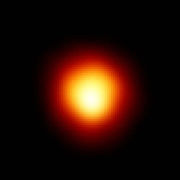Betelgeuse, as well as being an 80's classic film is one of the brightest stars in the sky. It is also Orion's right shoulder. It is one of the largest stars we know known as a red supergiant, with a mass about 20 times larger than the sun and a radius about 1000 times larger than the sun.
 This week Charles Townes from Berkley in California has announced that its radius has shrunk by about 15% over the last 15 years and this contraction is getting faster.
This week Charles Townes from Berkley in California has announced that its radius has shrunk by about 15% over the last 15 years and this contraction is getting faster.
This is interesting because Betelgeuse is already in the closing stages of its life despite only being about 8-9 million years old where as our sun is about 5 billion years old.
It is so large that its gravity crushes the gasses in its cores to much higher pressure and temperature than our sun. This speeds up the nuclear fusion reactions going on and means that Betelgeuse has already burned up all its hydrogen, When this happens to a star its core cools down, and as the only thing which supports the star against gravity is gas pressure, the core starts to collapse, as it does this it heats up until it can start burning helium to form carbon.
Depending on the size of the star this process can occur several times, each time the core gets smaller and hotter, and starts burning heavier elements. first it burns Hydrogen then Helium, to form Carbon, and this reacts to from Neon then oxygen and Silicon. At each stage the nuclear reactions release less energy until there is nothing left to burn.
The change in size of Betelgeuse indicates that something interesting is happening in the core.
Why is this interesting to anyone other than Astronomers? Well in a large star like Betelgeuse, eventually there are no more reactions to take place, and the core keeps shrinking until it effectively forms a huge atomic nucleus - a neutron star. This releases an immense amount of gravitational energy (about 1/4 of E=mc2) and the star explodes incredibly violently as a supernova.
If Betelgeuse goes supernova it will be as bright as the full moon but concentrated into a point, and it will be visible during the day for several months. It is 600 light years away so although it would be close enough to be spectacular, it should be distant enough to be safe for the planet earth.
Whether it will actually go bang in the next few years, nobody knows, as we have never watched the early stages of a supernova, as they are so rare, and noone has been lucky enough to have a telescope pointing at the right star at the right time, but if it does it should be spectacular.
References
- Previous Green way to terminate termites
- Next Typhoons trigger earthquakes










Comments
Add a comment